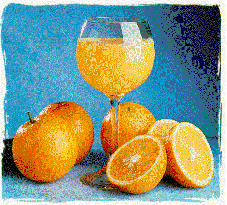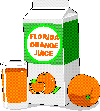 The
Orange Juice Production Process and Product Forms*
The
Orange Juice Production Process and Product Forms*  The
Orange Juice Production Process and Product Forms*
The
Orange Juice Production Process and Product Forms* * Reprinted
from Morris Citrus Economics Newsletter, Volume One, Issue Eight, with
permission from Allen Morris. Copyright© 1996 by Morris Agribusiness Consulting,
Inc., 4002 67th Street Court East, Bradenton, FL 34208; Tel: (941) 749-5068.
Oranges are hand-picked in the field, loaded into trailers and delivered to the processing plant. Oranges do not ripen after picking and the deterioration process begins as soon as they are separated from the tree. The fruit is dumped from trailers onto conveyers where it is carried through a washing process. The fruit is then graded, and oranges not acceptable for processing are separated and diverted to be used for by-products. The U.S. Dept. of Agriculture (USDA) then tests for juice and solids content, the unit of payment for growers, after which the oranges are diverted to storage bins labeled according to juice specifications represented by each tested load of fruit. Oranges are then selected from labeled bins to enable blending juice of optimal quality and transported via conveyor to juicing machines (extractors). After juice extraction, the stream of pulpy juice goes through a finisher (screen) where the pulp and seeds are removed, and along with the peel, diverted to be used for by-products. At this stage, the juice is made into one of two product forms: bulk frozen concentrated orange juice (FCOJ) or not-from-concentrate (NFC).
Juice made into bulk FCOJ is sent to an evaporator where vacuum and heat are used to remove excess water in order to obtain a base concentrate of 65° brix, which is a seven-to-one strength ratio to normal single-strength juice. The bulk FCOJ is then stored at 20°F or lower in a tank farm or in 55-gallon drums until it is sold or packaged for sale.
Juice made into NFC is de-oiled to .02%-.04% oil levels with a centrifuge, then either pasteurized, chilled and packaged or stored for future sale and/or packaging. NFC is stored a number of ways: frozen as blocks in warehouses; frozen in 55-gallon drums; pasteurized and chilled in large stainless steel aseptic tanks; or, pasteurized and chilled in 4'x4' wooden boxes containing a plastic bag which holds about 300 gallons of juice.
Bulk FCOJ is packaged by orange juice marketers into either frozen concentrated orange juice or chilled reconstituted (recon) ready-to-serve (RTS) orange juice. Packaged FCOJ is made by adding single-strength juice or water and flavor oils and essences to bulk FCOJ to reduce it from 65° brix to 42° brix, which is a four-to-one strength ratio to normal single-strength juice. Then the product is packaged into 6-, 12-, or 24-oz. cans and sold in frozen form. To convert this FCOJ into ready-to-drink orange juice, consumers thaw it and then mix it with three parts water.
 Recon
RTS
Recon
RTS Recon RTS is made by adding water and flavor oils and essences to bulk FCOJ to reduce it from 65° brix to 11.8° brix, pasteurizing it, packaging it in cardboard cartons or glass containers and selling it as chilled RTS orange juice.
Jump back to The Ultimate Citrus Page - FCOJ